My initial attitude about making peanut brittle was similar to my concept of writing children’s books: Phhh — I can do that. Mix some corn syrup and a handful of peanuts/write a couple of simple sentences and whallah! How hard can it be? Well — I’m in the hands-on-the-ground-I’m-not-worthy position begging mercy again — this time from peanut brittle chefs. The creative process is not as easy as they make it look.
I started the way any self-respecting chef does. I Googled for a recipe with the word “best” in it. Mom’s Best Peanut Brittle rose to the top of the Google chain. The word “mom” offered a comforting bonus.
I ignored the video portion. I didn’t need it. Phh — how hard could it be?
In the text, Amanda, the generous gal who submitted the recipe, said to move quickly to get the mixture out of the pan once it reaches 300 degrees. I didn’t have a candy thermometer, so I tried to guess when it was 300 degrees. I stirred in the butter and baking soda per the instructions and poured it in the pan to cool. I assumed it magically turned the desired peanut brittle color.
Two hours of running in and out of our cold garage to check the status, I learned it doesn’t. I obviously hadn’t heated the mixture to 300 degrees. (Kind of like some my half-baked manuscripts that I’ve sent to agents, family, and friends.)
So, I Googled Salvaging Undercooked Peanut Brittle and followed Tiffany’s helpful instructions to throw the pieces back in the pan, turn the heat up and stir, stir, and stir to a raging boil and wait to pour it in the pan until it reaches 300 degrees. I had to take the pan off the burner midway, because I forgot to grease my aluminum foil, but eventually I had a boiling mixture that turned the color of peanut brittle. This looks better, don’t you think?
I thought so, too. I pried the last glob off the spoon with my teeth before preparing the spoon for the dishwasher. The mixture burnt the roof of my mouth. Then, my teeth stuck together and I had to wait until it melted, so I wouldn’t pull off a crown. I had considered sending some in a care package to a relative in the nursing home, but I envisioned her pulling out her sloppy upper and lower dentures, cemented together by my peanut brittle…and I changed my mind.
Again, I set the mixture on a shelf in the garage. It did eventually cool enough to break. I was so excited I put some of it in a holiday bag on my counter and the rest in the freezer. The stuff in the bag melted together to make one big glob. (In the writing stage, this is when I submit the manuscript at draft #781 and I should have waited until draft #962.)
Not to be beaten down by a blob of peanut brittle, I scoured the pans, slopped some butter on more aluminum foil and threw the obstinate concoction on the stove again.
Burnt peanuts — not so tasty. The pan — and my temper — too hot, so the pan and I chilled as I chisled the brittle from the burnt pan into a mellower pan. Then, I stirred and stirred and stirred some more — until my right bicep popped out of my shirt.
The concoction hardened immediately and shattered when I looked at it cross. Ta da! I ran up my stairs with the Rocky Balboa theme song in my head. Then I forgot what I went there for.
Hopefully some of the peanut brittle will stay separated enough for our son to taste at his military base. If not, he can throw it in the air for skeet shooting practice.
Or, he could tie it to a stick and use it for spear fishing. (I watch Survivor.)
Or, maybe I’ll just buy peanut brittle from someone else. Then I’ll have ten extra hours to be humbled writing children’s books.
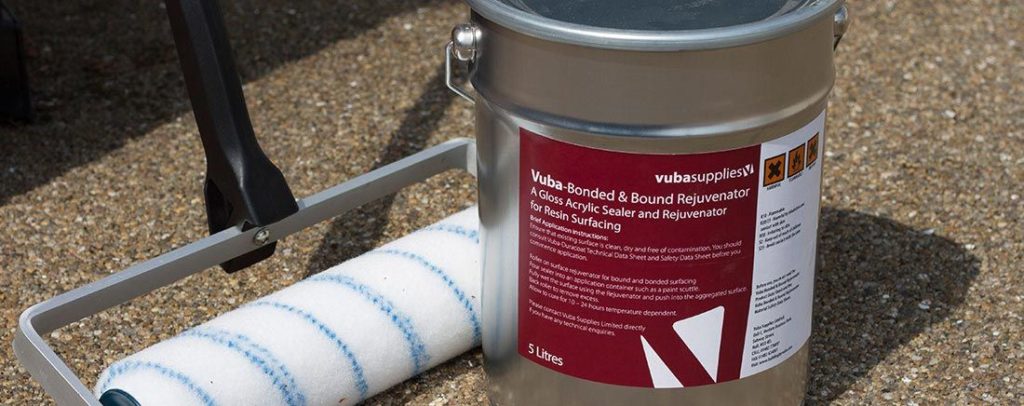
Children’s Book Author/Dragon Slayer/Dreamer Search
My initial attitude about making peanut brittle was similar to my concept of writing children’s books: Phhh — I can do that. Mix some corn syrup and a handful of peanuts/write a couple of simple sentences and whallah! How hard can it be? Well — I’m in the hands-on-the-ground-I’m-not-worthy position begging mercy again — this time from peanut brittle chefs. The creative process is not as easy as they make it look.
I started the way any self-respecting chef does. I Googled for a recipe with the word “best” in it. Mom’s Best Peanut Brittle rose to the top of the Google chain. The word “mom” offered a comforting bonus.
I ignored the video portion. I didn’t need it. Phh — how hard could it be?
In the text, Amanda, the generous gal who submitted the recipe, said to move quickly to get the mixture out of the pan once it reaches 300 degrees. I didn’t have a candy thermometer, so I tried to guess when it was 300 degrees. I stirred in the butter and baking soda per the instructions and poured it in the pan to cool. I assumed it magically turned the desired peanut brittle color.
Two hours of running in and out of our cold garage to check the status, I learned it doesn’t. I obviously hadn’t heated the mixture to 300 degrees. (Kind of like some my half-baked manuscripts that I’ve sent to agents, family, and friends.)
So, I Googled Salvaging Undercooked Peanut Brittle and followed Tiffany’s helpful instructions to throw the pieces back in the pan, turn the heat up and stir, stir, and stir to a raging boil and wait to pour it in the pan until it reaches 300 degrees. I had to take the pan off the burner midway, because I forgot to grease my aluminum foil, but eventually I had a boiling mixture that turned the color of peanut brittle. This looks better, don’t you think?
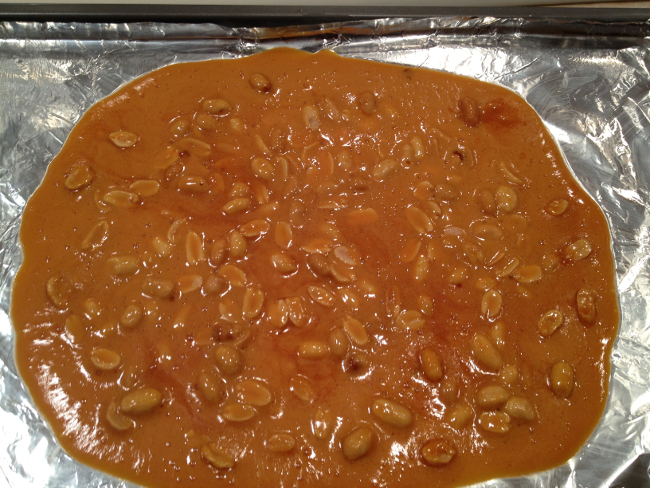
I thought so, too. I pried the last glob off the spoon with my teeth before preparing the spoon for the dishwasher. The mixture burnt the roof of my mouth. Then, my teeth stuck together and I had to wait until it melted, so I wouldn’t pull off a crown. I had considered sending some in a care package to a relative in the nursing home, but I envisioned her pulling out her sloppy upper and lower dentures, cemented together by my peanut brittle…and I changed my mind.
Again, I set the mixture on a shelf in the garage. It did eventually cool enough to break. I was so excited I put some of it in a holiday bag on my counter and the rest in the freezer. The stuff in the bag melted together to make one big glob. (In the writing stage, this is when I submit the manuscript at draft #781 and I should have waited until draft #962.)

Not to be beaten down by a blob of peanut brittle, I scoured the pans, slopped some butter on more aluminum foil and threw the obstinate concoction on the stove again.

Burnt peanuts — not so tasty. The pan — and my temper — too hot, so the pan and I chilled as I chisled the brittle from the burnt pan into a mellower pan. Then, I stirred and stirred and stirred some more — until my right bicep popped out of my shirt.
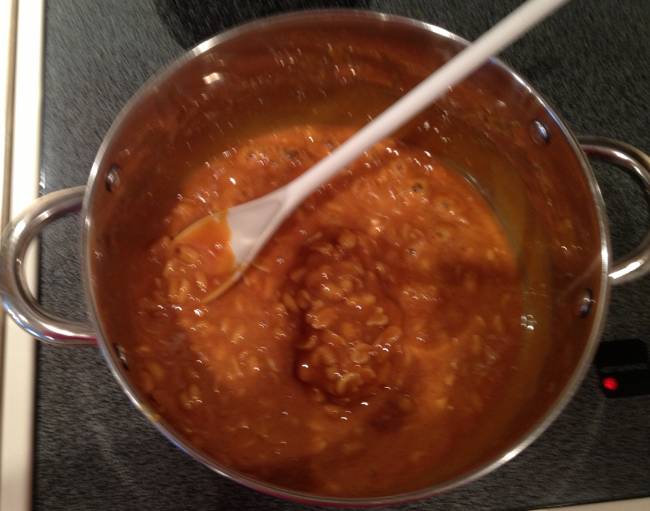
…and the tip of my spoon melted.
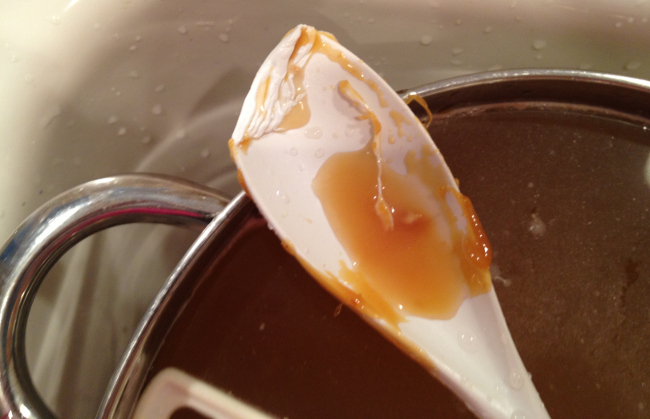
Now we’re going to die of plastic spoon poisoning.
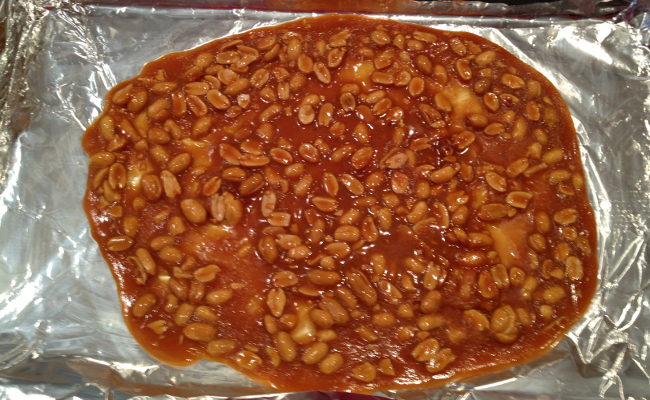
The concoction hardened immediately and shattered when I looked at it cross. Ta da! I ran up my stairs with the Rocky Balboa theme song in my head. Then I forgot what I went there for.
Hopefully some of the peanut brittle will stay separated enough for our son to taste at his military base. If not, he can throw it in the air for skeet shooting practice.
Or, he could tie it to a stick and use it for spear fishing. (I watch Survivor.)
Second thought — there’s not much fishing where he is.
Next year: less peanuts, more patience, a wooden spoon, and a candy thermometer.
Or, maybe I’ll just buy peanut brittle from someone else. Then I’ll have ten extra hours to be humbled writing children’s books.
How To Make Easy Old Fashioned Peanut Brittle | Peanut Brittle Recipe
FAQ
Why is my brittle not hardening?
What makes brittle hard?
How long does it take for brittle to set?
Why is my brittle soft?
How long does peanut brittle take to harden?
How long does it take for peanut brittle to harden? Once you’ve spread your peanut brittle onto parchment paper or a silicon mat to cool, it can take around 20-30 minutes for the peanut brittle to harden. Weather may affect the peanut brittle and if it’s more humid than it may take a little longer or may not harden completely.
Why is my Brittle not hardening properly?
If your brittle is not hardening properly, chances are that the mixture did not heat up enough to reach the hard crack stage. Once it reaches the hard crack stage the brittle will be more dry and less sticky, allowing it to harden properly.
Why is my homemade peanut brittle not brittle?
If your homemade peanut brittle isn’t brittle, it’s most likely because it did get hot enough before you took it off the burner. In order to get a peanut brittle that is firm and cracks under pressure, you need to cook the candy to roughly 350 degrees Fahrenheit. Baking soda is also very important to peanut brittle.
What equipment do you need to make homemade brittle?
Making homemade brittle requires a baking sheet, a saucepan, and a candy thermometer. 1. Candy Thermometer – This is the most paramount equipment when making any homemade candy, such as fudge, toffee, or brittle. Temperatures must be spot on for the recipe to work.
